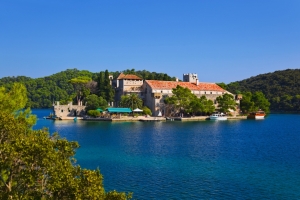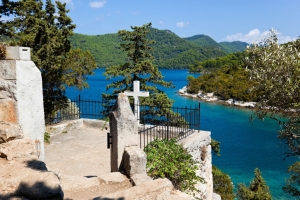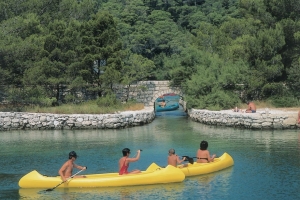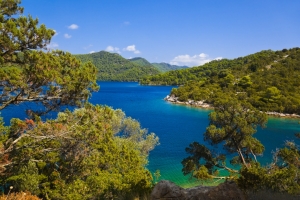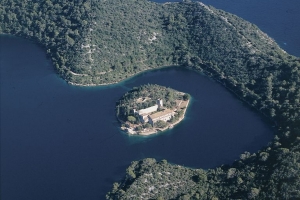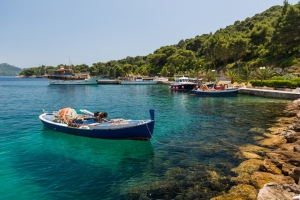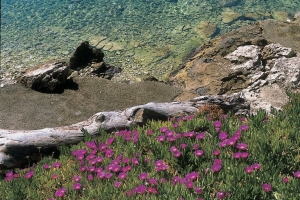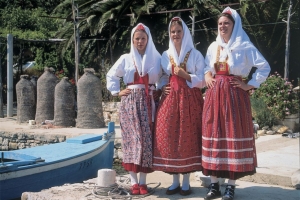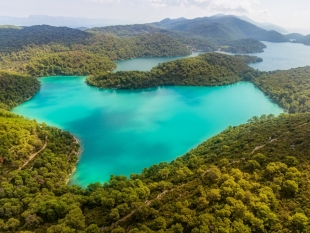


Croatia's Idyll by Dubrovnik
In the midst of the greenest island in Croatia, also called the Odysseus Island because this is where he, according to the legend, was lured by the nymph Calypso for the duration of entire seven years. This island, rich in flora consisting of Aleppo pine, pines, fig trees and holm oaks and fauna consisting of mongooses, which are rare to the region, has all that is indicative of the National Park Mljet. Since 1960 the National Park has occupied approximately one-third of the same island, a few kilometers from the southern Croatian city of Dubrovnik. The waters around and on the island of Mljet are crystal clear and smooth as glass, and the reason why the national park two salt lakes and the fish-rich Adriatic attract tourists wanting to go swimming, diving and snorkeling. The two salt lakes Veliko Jezero and Malo Jezero, which are connected by a channel, were created over 10,000 years ago. Pine and scrub that surround the lakes, provide shade and are responsible for the lovely smell in the air. In Veliko Jezero you can visit the small island monastery Saint Maria, which houses a built in 12th century Benedictine monastery, which today serves as a romantic restaurant. While diving and exploring in the Adriatic, you might, with a little luck, discover a reef with yellow coral. These are particularly rare, which is why the park administration does not reveal the location of the reefs. But divers must not be disappointed if they do not discover the reef: The underwater world here is rich in various species of fish and other sea creatures.
A Paradise for Divers, Hikers and Bicyclers
On land, the mongooses are among the highlights of the Mljet National Park. They were reintroduced to the island in 1909 to get the local snake problem under control. The mongooses eliminated the problem, but at the same time, by eating other snakes, bird eggs and small animals, also made it so that the fauna in the National Park could be lush. While gazing at the waters, one might be fortunate enough to catch a glimpse of the rare Mediterranean Monk Seals, which are extremely endangered. Also, deer, wild boars and hares inhabit the island. The wild boar are, however, a problem for the residents of the Mljet National Park because they destroy the vineyards and olive groves. For the residents who live in about six settlements in the National Park, the preservation of the park and its vegetation is very important. For this reason, they strive to achieve a good balance between environmental protection and tourism, which is one of their mainsources of income. Likewise, they earn their money through fishing and agriculture.
Mljet National Park is an area as diverse as the sport activities it offers. It is a perfect place for anyone interested in extensive walking trails and for cycling routes, which go around the two lakes. Amidst the pine forests of the island as well as in remote coves you will find places where you can relax by taking a walk or riding your bike. A very nice experience is to see the panorama at the Port of Soline. For those who want to wander a bit, a climb on the Montokuc, the highest mountain on the island, provides the perfect opportunity. Once at the top, you can look over the tops of the trees and enjoy a fantastic view. More hiking trails and bike routes are marked throughout the park.
From Dubrovnik to the Greenest Island in Croatia
The ideal starting point for a trip to the National Park Mljet is Dubrovnik, just a few kilometers from the Croatian mainland. There are two additional ferry services from the opposite peninsula of Peljesac, that will take you to Prapratna luka and Trstenik. The ferry brings visitors from Dubrovnik to Sobra or Polace several times a day. Due to the fairly well-developed road network, it is easy to get to the island's attractions, which include Roman monuments and Illyrian ruins. The D120 road drives through the entire island to Mljet National Park. It is also possible to take your own boat and dock in Sobra or Polace and then take the bus from there.
Access is only possible via the entrances in Crna Klada, Pomena and Polace. Admission to the park costs around 12 Euros and parking and picnic facilities are available at the entrance for free. There are no entrance fees for children under 6 years of age.

Location

Why Best of Croatia ?
- Best Price Guaranteed
- No booking fees
- Thousands of satisfied customers
- Numerous objects with direct-booking option
- Intelligent search function with numerous useful filter options
- Extensive travel guide with lots of pictures and videos over 500 pages
- Detailed beach guide with more than 700 beaches







 Best of Croatia
Best of Croatia










